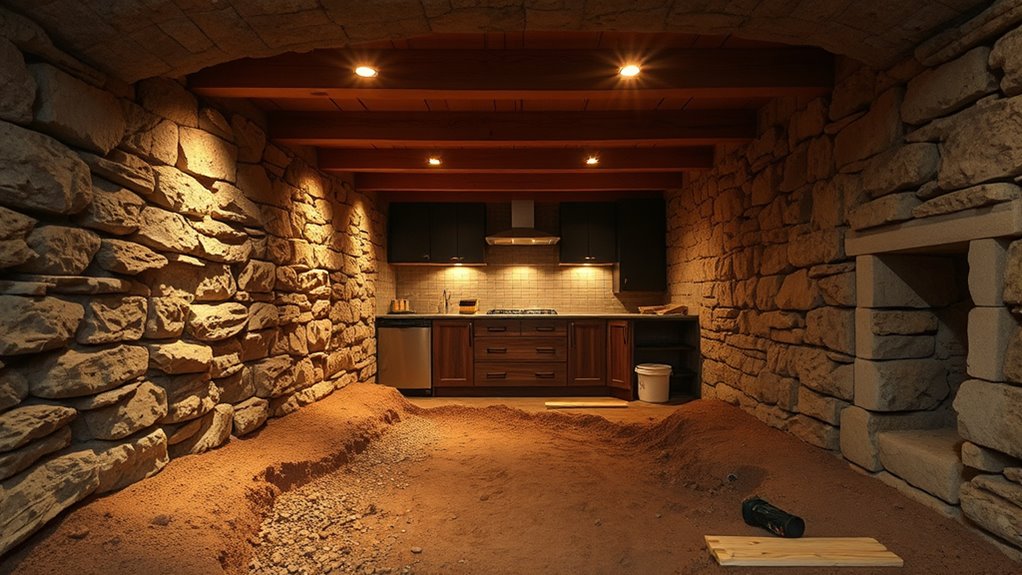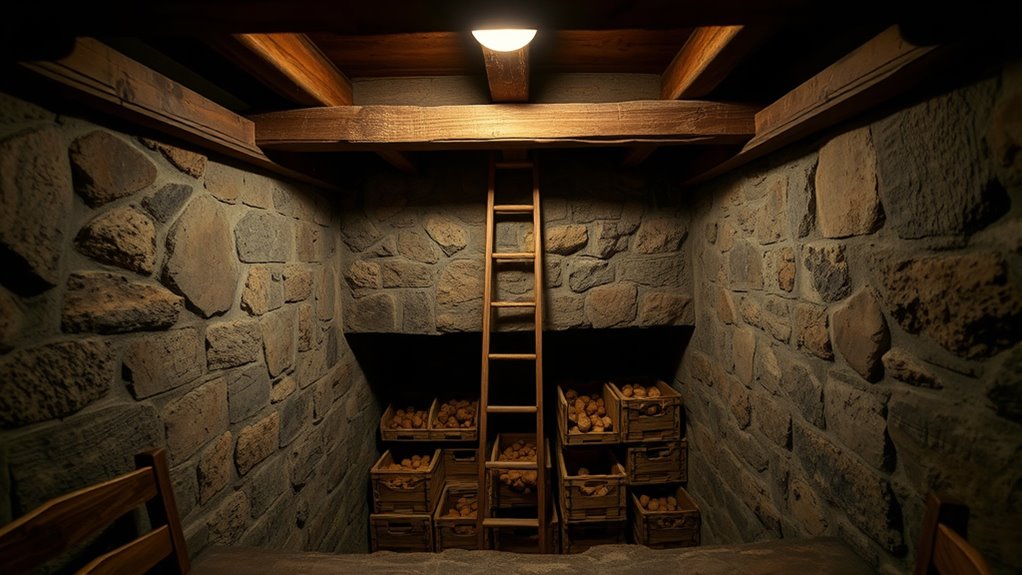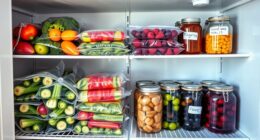When building a root cellar beneath your kitchen, start by planning for proper waterproofing and ventilation to prevent moisture buildup and mold. Guarantee you choose a solid, well-drained foundation and install waterproof barriers with drainage systems. Design your vents with dampers to control airflow and prevent water intrusion. Seal all joints and entry points tightly. The key is creating an environment that stays cool, humid, and protected—stick with us to find out how to get it just right.
Key Takeaways
- Ensure a solid, waterproof foundation designed for underground moisture and groundwater conditions.
- Plan for proper ventilation with vents at different heights and adjustable dampers to control airflow.
- Use waterproof membranes and extend barriers above ground to prevent water seepage into the cellar.
- Seal all penetrations, including doors, vents, and electrical wiring, to maintain a sealed, humidity-controlled environment.
- Incorporate drainage systems and moisture-resistant insulation to promote long-term durability and produce preservation.

If you want to preserve your harvest and keep produce fresh longer, building a root cellar under your kitchen is a practical solution. This space offers a cool, dark, and humid environment ideal for storing vegetables, fruits, and preserved foods. Before diving into construction, understanding the essentials—particularly ventilation requirements and waterproofing techniques—is essential to guarantee your root cellar functions properly and stays durable over time. Proper ventilation is indispensable to control humidity and prevent mold or spoilage. Without adequate airflow, moisture levels can rise, leading to rot or fungal growth that destroys stored produce. You need to plan for intake and exhaust vents that promote continuous air circulation, ideally placing them at different heights to allow fresh air to enter and stale air to escape. Using vents with adjustable dampers gives you control over airflow, enabling you to fine-tune conditions based on seasonal changes or stored items’ needs. Additionally, integrating automation technologies can help monitor and adjust environmental conditions automatically, ensuring optimal storage settings without constant manual oversight.
Waterproofing techniques are equally important because moisture infiltration can compromise the integrity of your root cellar. To keep water out, you should start with a solid, well-drained foundation. Consider applying a waterproof membrane or coating to exterior walls, especially if your site is prone to groundwater seepage. Extending waterproof barriers above the ground level prevents water from creeping in through the walls. Proper drainage around the cellar is essential; installing a gravel bed or drainage tile helps divert water away from the structure. Inside, sealing cracks and joints with high-quality waterproof sealants adds an extra layer of protection. Ventilation openings should also be carefully designed to prevent water ingress, with dampers or covers that shed rain and snow.
In addition, you’ll want to insulate your root cellar to maintain stable temperatures and further safeguard against moisture issues. Use moisture-resistant insulation materials and ensure all penetrations for vents or electrical wiring are properly sealed. When planning your underground space, think about how you’ll access it—an exterior door or hatch should be sealed tightly to prevent water entry and air leaks. The goal is to create a sealed, well-ventilated environment that stays consistently cool and humid without becoming damp or moldy. By paying close attention to ventilation requirements and waterproofing techniques from the start, you set a strong foundation for a durable, efficient root cellar that protects your harvest for months to come.
Frequently Asked Questions
How Much Does It Typically Cost to Build a Root Cellar?
The cost estimation for building a root cellar varies based on size and materials, but generally, you can expect to spend between $2,000 and $10,000. To stay within your budget, you should plan your project carefully, considering excavation, insulation, and ventilation. Budget planning ahead of time helps you identify necessary expenses and avoid surprises, ensuring your root cellar project fits your financial situation comfortably.
Do I Need Special Permits for Underground Construction?
Think of permits as the secret keys to your underground treasure. You’ll likely need them to guarantee your project complies with zoning regulations and building codes. Check with your local authorities first, because failing to get proper permits can turn your root cellar into a legal maze. Usually, permits are required for underground construction, especially when it involves structural changes, so don’t skip this essential step to avoid future headaches.
What Are the Best Materials for a Root Cellar?
When selecting the best materials for your root cellar, you want insulation materials that regulate temperature and humidity, like rigid foam or spray foam. Moisture barriers, such as plastic sheeting or waterproof paint, prevent water infiltration and dampness. Use durable, non-porous materials for walls and floors, and guarantee proper sealing to maintain ideal conditions. These choices help preserve your stored produce and extend the cellar’s lifespan.
How Long Can Produce Be Stored in a Root Cellar?
Ironically, you might think your produce will last forever in a root cellar, but reality says otherwise. With proper produce preservation, your vegetables and fruits can stay fresh for several months—anywhere from 3 to 6 months, depending on the type. Storage duration varies, so plan accordingly. Keep the temperature consistent, and you’ll maximize your harvest’s lifespan, avoiding waste and savoring seasonal bounty longer than you’d expect.
Can I Convert an Existing Space Into a Root Cellar?
Yes, you can convert an existing space into a root cellar. First, evaluate its ventilation options to keep air circulating and prevent humidity buildup. Then, focus on moisture control by sealing cracks and installing a vapor barrier if needed. Guarantee the space stays cool, dark, and stable in temperature. Proper ventilation and moisture management are essential to keep your stored produce fresh and prevent spoilage.
Conclusion
Now that you’re ready to build your root cellar beneath the kitchen, imagine the endless possibilities of fresh, preserved produce right at your fingertips. But remember, the real challenge lies ahead—ensuring it stays cool, damp, and secure. Are you prepared to tackle the final steps? With careful planning and attention, your underground treasure trove could become the secret to year-round freshness. The next move could change everything—are you ready to make it?











